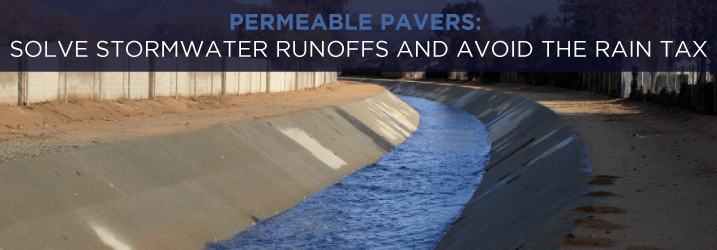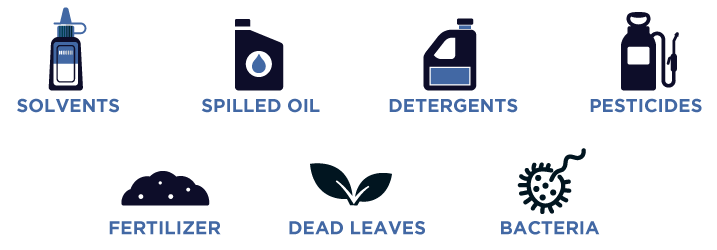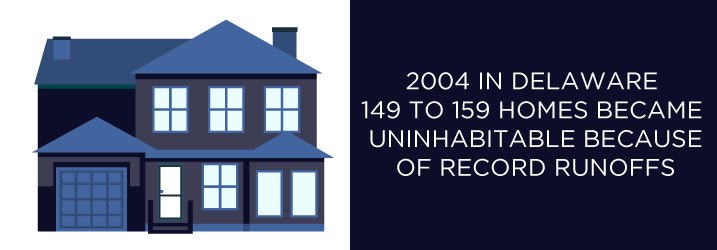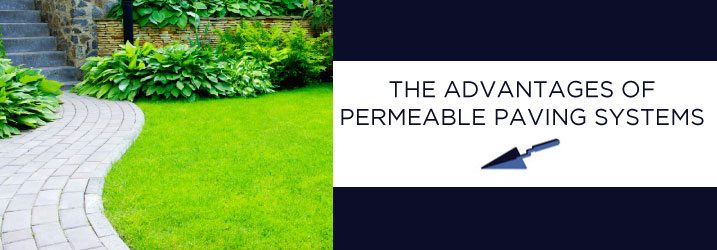Jump To:
- The Environmental and Health Effects of Stormwater Runoffs
- Permeable Paving Systems for Stormwater Management
- Permeable Pavers Suitable for Residential and Commercial Projects
- Permeable Paver Installations
- The Advantages of Permeable Paving Systems
In Maryland, New York, Washington, D.C. and other locations across the country, the issue of stormwater management has taken center stage because of the serious environmental hazard presented by stormwater runoffs. These runoffs, caused by urban sprawl and the proliferation of impervious surfaces, carry a variety of contaminants. The pollutants not only damage the environment, but also leave a litany of health, social and economic problems in its aftermath.
Impervious surface or impervious cover, references anything that impedes water and prevents it from penetrating, including patios, driveways, residential, rooftops, public buildings, commercial structures and parking lots. This type of surface prevents rainwater and snow from soaking into the ground, resulting in contaminated stormwater.
In addition to affecting the quality of the water that runs into our water bodies, impervious covers also modify the volume of the runoff, which degrades and changes the physical nature of existing streams. Water flows more quickly from an impervious area, which generates more intense downstream flow, and consequently more flooding. When less water soaks into the ground, water tables can drop. This means creeks, wells and streams fed by the groundwater begin to dry up.
The Environmental and Health Effects of Stormwater Runoffs
Gutters, downspouts, and paved surfaces facilitate the collection and movement of stormwater. In fact, research shows that the pavement installed for vehicular traffic and usage comprises two-thirds of all impervious surfaces. Stormwater flows across sidewalks, down the street and through parking lots. It picks up contaminants typically linked to air pollution particles, moves to storm drains and finally into the local rivers and streams.
Pollutants contained in stormwater runoff include:
There are also numerous other toxins, chemicals and byproducts present in the runoffs that cause harm to the environment.
The lack of a natural filtration process sits at the core of the stormwater runoff problem. When rainwater falls on rooftops, traditional pavements and other impervious surfaces, it bypasses nature’s process of water filtration through the soil. The runoff simply flows through the storm drainage systems into the rivers and streams and other tributaries.
The Prince George’s County, Maryland Stormwater Management website lists the following harmful effects associated with stormwater runoff:
- Bacteria and other pathogens create health hazards for people and wildlife.
- Debris such as plastic bags, six-pack rings, bottles and cigarette butts can choke and kill aquatic life such as ducks, fish, turtles and birds.
- Excess nutrients cause algae blooms that can destroy aquatic habitats and impact recreational opportunities.
The Social and Economic Impact of Impervious Surfaces
Many municipalities have seen firsthand the impact of existing impervious cover runoff on a community. For example, in Northern Delaware an entire community of 149 to 159 homes became uninhabitable because of record runoffs, which occurred in September 2004.
In addition, numerous homes and communities in other areas became uninhabitable because of increased runoffs and discharge rates. The increase in impervious surfaces in the area, along with poor planning, created a situation that prevented absorption of the runoff. Not only does it cost the local county, state and federal government large amounts of money, but it also affects the insurance companies that must take care of displaced residents.
While some people tend to focus on the upfront costs of reducing impervious cover, better planning can help reduce the impervious surfaces in new development. The local community benefits, as well as the environmental health of rivers and streams. It also results in economic cost savings for the community, governmental entities and others.
The U.S. Environmental Protection Agency (EPA) reports that the amount of impervious surfaces on an average urban block produces in excess of five times the runoff generated from a forested area of an equivalent size. Between 1990 and 2007, impervious cover associated with new single-family home developments increased about 34 percent.
In April 2013, Maryland became the first state to enact a stormwater management fee, known as the rain tax, which applies to ten of the twenty-four counties in the state. The Maryland legislature passed the law in response to an EPA mandate. The new rule imposes new environmental standards for Maryland, Pennsylvania, Virginia, New York, Virginia, West Virginia and the District of Columbia, which are designed to reduce the pollution levels in the Chesapeake Bay.
The EPA allows each state to determine how it would comply with the new law. Maryland chose to levy a new fee designed to recover the cost of providing stormwater management services, based on the amount of the impervious surface areas, including roofs, driveways and parking lots.
Each of the ten jurisdictions in Maryland that have authority to levy the tax can decide the rate. One county decided to make the cost to property owners symbolic, charging a $1 annual fee. Legislators in Arundel County passed legislation that would require some homeowners to pay as much as a $170 annual fee.
Permeable Paving Systems for Stormwater Management
Fortunately, new technologies allow for the installation of pervious materials, such as permeable paving systems, which allow water to flow through into the soil below the surface. These systems consist of paved areas that generate less stormwater compared to other areas that have standard paving materials.
The reduction in stormwater occurs mainly through the penetration of a greater amount of the rain falling on the area, compared to conventional systems. Pervious paving system classifications depend on the pervious paving surface course and if the installation process includes a runoff storage bed underneath the surface course.
The three classes of pervious paving systems are as follows:
- Porous paving. Consists of porous asphalt concrete paving installed over a runoff storage bed made of uniformed, graded broken stone.
- Permeable pavers with storage bed. This solution is composed of impervious pavers with surface voids constructed over a runoff storage bed of uniformly graded broken stone.
- Permeable pavers without storage bed. This uses impervious pavers with surface voids built over a structural bed of crushed stone.
Permeable pavers offer a viable solution that effectively solves the issue of stormwater runoff, making it suitable for a variety of both residential and commercial applications. The system provides a stable load-bearing surface that allows stormwater to penetrate through the surface to the soil underneath.
A pervious surface operates in a similar manner as the process that allows for the filtration of drinking water, which removes unwanted particles and impurities. The penetration of the water from a pervious surface reduces a number of the environmental problems commonly linked with water runoff because the water filters through the soil particles as it flows to groundwater aquifers and surface waters.
When you start your investigation of permeable pavers in Maryland, make sure you do not confuse the three types of pavers available in the marketplace: porous, pervious and permeable. Here is a short description of each:
- Porous pavers. This refers to a cellular grid system that the installers fill with sand, dirt or gravel. It functions as grass reinforcement, ground stabilization and gravel retention system, with a surface level composed of compacted gravel or a layer of topsoil seeded with grass and fertilizer.
- Pervious pavers. This material allows the water to percolate through the surface of the material, which prevent runoffs into storm drains and the surrounding area.
- Permeable pavers. This describes a layer of concrete or fired clay brick. During the installation process, the installer separates the pavers by joints filled with crushed stone. Permeable pavers allow rainwater to pass around the pavers, as opposed to through it.
Remember, the term permeable describes the various paving methods for walkways, roads and parking lots, which permit water and air to circulate the pavers. The water enters the joints between the paving materials.
Permeable Pavers Suitable for Residential and Commercial Projects
For the typical residential installation, many homeowners choose permeable interlocking pavers because of its esthetic beauty. In addition, permeable pavers allow property owners to customize the design layout, shape, size and color to meet their individual needs and preferences.
Here are some of the common uses of permeable pavers:
- Pedestrian paths
- Public parks
- Walkways
- Alleyways
- Plazas
- Residential and commercial driveways
- Patios (private, public and commercial)
- Parking lots (private, public and commercial)
- Residential and commercial garages
- Playgrounds (residential and commercial)
- Private, commercial and public, gardens
- Golf cart lanes
- Fire lanes
- Emergency access lanes
- Boat parking areas
The durability and versatility of permeable pavers also make it a solid stormwater management solution for commercial applications. The Tide Water Community College in Virginia Beach, VA recently developed a 62,000 square foot parking area at their new Regional Health Professions Center to control stormwater runoff. To make the area more attractive, they installed the innovative AquaPave Permeable Paving System. The interlocking paver system was manufactured by Nitterhouse Masonry Products, LLC, and it captured and filtered the storm water. This solution shows the power of permeable pavers on an application that impacts a commercial setting.
Permeable Paver Installations
You can determine the areas on your property with the elements necessary for permeable pavers by first identifying any existing impervious surfaces or areas that you want to pave.
Prime locations, where permeable pavement can improve rainwater infiltration, include patios, sidewalks and driveways. The installation area must have a slope or gradient that will direct water away from the foundation of the building and other nearby structures.
The areas must have a slope of less than 5 percent. You should exclude any surfaces where you have a high accumulation of sediment and debris. These conditions can clog the surface, which reduces the effectiveness of the system. In addition, avoid using permeable pavers in areas with high levels of pollutants because the stormwater will not undergo any pre-treatment before infiltration.
Follow the manufacturer’s recommendations for the installation process to ensure that you receive the full protection of the product warranty. After the site preparation, which typically entails the excavation of the site and a layer of gravel, the installer places a geotextile fabric (Inbitex Filter Fabric) over the gravel. The fabric utilizes a microbial action that filters 99.9 percent of oil and hydrocarbons and as much as 97 percent of heavy metals from stormwater.
The next step of the process requires the installer to apply a sand layer over the fabric.
After the placement of each paver, either by hand or with a special machine, the installer fills the gaps between the pavers with soil, sand pea gravel or washed gravel, which completes the installation.
The University of Maryland recommends the following considerations for the installation of a permeable paving system:
- Frost heave. Cold climates may require the placement of the base course below the frost line.
- Contiguous drain areas. Make sure the site of the permeable paver installation site does not receive runoffs from other areas.
- Sub base. The type and depth determine the amount of water infiltration and durability. Colder climates and poor soil require a thicker sub base.
- Proper installation. Hire a certified contractor and purchase ADA compliant permeable pavers if required.
- Maintenance. Follow the manufacturer requirements to maintain the effectiveness and durability of the system.
The overall maintenance goal for the installation of a permeable paving system is to prevent clogging surface material. Do not seal or repave the pavers or joints with porous materials. Sweep or vacuum any debris to prevent obstruction and water flow to the soil.
The costs for a permeable paver project will differ depending on a variety of factors, such as the size of the area, soil condition and the application chosen. The cost estimate for permeable pavers runs about 20% more than traditional systems.
The Advantages of Permeable Paving Systems
Property owners, businesses, not-for-profits and other organizations can help reduce the quantity of stormwater contaminants with the installation of permeable pavers. These pollutants harm the waterways and other ecological resources, jeopardize human health, curtail recreation opportunities and cost taxpayers millions of dollars.
Decreasing the amount of impervious surfaces yields the following benefits:
- Reduces stormwater runoff, localized flooding and soil erosion.
- Reduces the flow of over-load to sewage treatment plants.
- Reduces the amount of land needed for stormwater management.
- Requires less land and building of retention basins.
- Reduces the need for the irrigation of areas plants (rain seeps into the outlying areas).
- Replenishment of groundwater and improved water quality via the natural filtration.
Some jurisdictions like Prince George County and Montgomery County offer rebates to both residential and commercial property owners who convert existing hard, impervious surfaces to a permeable paver system.
For example, owners of commercial, multi-family and institutional properties who install a minimum of 450 square feet of permeable pavers qualify for a rebate under The RainScapes Rewards Rebate Program. Residential property owners must qualify with a minimum surface replacement area of 150 square feet. Prince George County offers The Rain Check Rebate Program to assist property owners in its jurisdiction.
Learn More about Permeable Pavers
Residential, commercial, institutional, and non-profit property owners can help conserve water and support healthy waterways by replacing existing asphalt or conventional concrete impervious surfaces with permeable pavers.
Suitable for both large and small project areas, permeable pavers offer one of the most environmentally friendly paving solutions available to help achieve pollution-reduction targets.
To learn more about permeable paving systems, visit our products page. Most dealers are located in the Mid-Atlantic region. We’re also expanding into the Midwest – find your dealer today.






